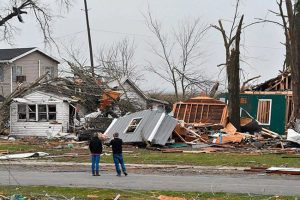In the complex world of insurance claims, understanding what is covered and what isn’t can often feel like navigating a maze. One area that frequently becomes a point of contention between policyholders and insurance companies is the coverage of mold damage. Insurance policies typically cover “sudden and accidental” losses, but when it comes to mold, insurers are quick to deny claims, arguing that mold growth indicates a problem that has developed over time. However, the reality is that mold can start to form in as little as 24 hours under the right conditions, challenging the notion of what is considered “sudden and accidental.”
This post aims to demystify this issue, offering insights for homeowners and emphasizing how public adjusters, especially in Texas, can play a pivotal role in advocating for fair treatment under these circumstances.
Table of contents
- Definition and Insurance Policy Context
- Common Misconceptions and Clarifications
- Conditions for Mold Growth
- Timeline of Mold Development
- Factors Influencing Rapid Mold Formation
- Typical Insurance Responses to Mold Claims
- Examples of Policy Exclusions and Limitations
- The Impact of Mold Exclusions on Claim Outcomes
- Documenting Evidence of Sudden and Accidental Loss
- The Importance of Prompt Action and Professional Assessment
- Tips for Communicating with Insurance Companies
- How Public Adjusters Can Assist in Mold Damage Claims
- Case Studies or Examples Where Public Adjusters Made a Difference
- Navigating Policy Language and Advocating for the Policyholder
- Steps to Minimize the Risk of Mold Growth
- Maintenance Advice to Prevent Long-Term Moisture Issues
- How to Strengthen Your Position Before a Potential Claim
- Conclusion
- FAQ

Understanding “Sudden and Accidental” Coverage
Definition and Insurance Policy Context
The term “sudden and accidental” is frequently used within insurance policies to define the scope of coverage for damages. In essence, this phrase is meant to cover incidents that occur abruptly and without warning, contrasting with issues that develop over time due to neglect or lack of maintenance. For instance, water damage from a pipe that suddenly bursts qualifies as “sudden and accidental,” whereas a slow leak that has been ignored for months and results in mold growth might not.
Insurance companies rely on this distinction to determine whether a claim falls within the policy’s coverage. The rationale is to encourage homeowners to maintain their properties while still providing a safety net for unforeseeable disasters.
Common Misconceptions and Clarifications
Misconception: Many policyholders believe that any damage not intentionally caused by the homeowner should be covered under the “sudden and accidental” clause. This misunderstanding can lead to frustration when claims for gradual damage, like long-term mold growth, are denied.
Clarification: “Sudden and accidental” refers to the nature of the incident leading to the damage, not the damage’s discovery. It’s crucial for homeowners to understand that insurance policies are designed to cover unforeseen events. For damage to be considered under this coverage, the cause must be immediate and unexpected from the perspective of the insured.
Misconception: If mold appears after an incident like a flood or a storm, it’s automatically covered because the initial cause was sudden and accidental.
Clarification: While the initial cause (e.g., a storm leading to water intrusion) may fit the sudden and accidental criteria, insurance companies assess mold claims based on the specific circumstances around the mold’s development. If mold growth could have been prevented through timely action by the homeowner, such as drying out the affected areas promptly, insurers may argue that the resulting mold damage does not qualify for coverage.
Misconception: All insurance policies treat “sudden and accidental” damage the same way.
Clarification: Coverage can vary significantly from one policy to another. Some insurers may offer endorsements that extend coverage to include certain types of water damage or mold that would otherwise fall outside the standard definition of “sudden and accidental.” It’s imperative for homeowners to thoroughly review their policy documents and understand the specific language and exclusions related to mold damage.
Understanding the nuances of “sudden and accidental” coverage is the first step in navigating the often complex landscape of insurance claims. This knowledge empowers homeowners to better assess their coverage, manage their expectations, and take proactive steps in maintaining their property to prevent disputes with insurers over mold damage claims.

The Science of Mold Growth
Understanding the conditions that lead to mold growth and the timeline for its development is essential for homeowners and insurance policyholders. This knowledge not only helps in preventing mold but also in making informed decisions when filing insurance claims related to mold damage.
Conditions for Mold Growth
Mold spores are ubiquitous in the environment, but they require specific conditions to start growing and become a problem within a home. The primary conditions include:
- Moisture: The most critical factor for mold growth. Water intrusion, high humidity, or condensation can provide the necessary moisture for mold spores to begin growing.
- Temperature: Mold typically thrives in temperatures that are comfortable for humans, roughly between 60°F and 80°F (15°C to 27°C). However, some species can grow in colder or warmer conditions.
- Food Source: Mold can feed on any organic material, including wood, paper, carpet, food, and insulation. Homes are filled with potential food sources for mold.
- Oxygen: Mold needs oxygen to grow but does not require light; hence, it can grow in dark areas.
Timeline of Mold Development
The timeline for mold growth can be surprisingly quick:
- 24 to 48 Hours: Under the right conditions, mold can start to grow within 24 to 48 hours after exposure to moisture.
- 1 to 12 Days: Visible mold colonies can start to appear. The exact time frame depends on the conditions and the type of mold spores present.
- 18 to 21 Days: In untreated conditions, mold can become well-established and harder to remove.
Factors Influencing Rapid Mold Formation
Several factors can accelerate mold growth, making some situations more prone to rapid mold development:
- Type of Water Exposure: Clean water (from a burst pipe, for example) is less likely to introduce additional contaminants that can facilitate mold growth compared to greywater (from appliances, bathtubs, etc.) or blackwater (sewage or floodwater), which can introduce nutrients that promote faster mold growth.
- Humidity Levels: High humidity levels, above 60%, can significantly speed up mold growth. Areas with persistent humidity, such as basements and bathrooms, are particularly susceptible.
- Ventilation: Poor ventilation in a home can trap moisture and create ideal conditions for mold growth. Well-ventilated spaces can help prevent mold by reducing moisture levels.
- Material Porosity: Porous materials like wood, drywall, and carpet absorb and retain moisture, providing a conducive environment for mold to root and spread quickly.
Understanding the science behind mold growth is crucial for effectively managing and preventing mold in homes. It also underscores the importance of quick action after water damage to prevent mold from starting. This knowledge is particularly relevant when dealing with insurance claims, as it highlights the need for immediate response to water-related incidents to minimize the risk of mold development, which might not be covered if deemed preventable.

Mold Claims & Insurance Policies
Navigating mold claims can be challenging for homeowners, largely due to the nuances of insurance policies regarding mold damage. Understanding how insurance companies typically respond to mold claims, the common policy exclusions and limitations, and the overall impact these factors have on claim outcomes is crucial for policyholders.
Typical Insurance Responses to Mold Claims
Insurance companies often approach mold claims with caution and scrutiny due to the potential for significant remediation costs and the complexities surrounding the causes of mold growth. Common responses include:
- Denial of Claims Based on Policy Exclusions: Many policies explicitly exclude mold damage or limit coverage to specific situations that do not include mold resulting from gradual water damage or high humidity levels.
- Claiming Maintenance Issues: Insurers frequently attribute mold growth to maintenance failures, arguing that the homeowner did not take appropriate steps to mitigate water damage or control humidity levels, thus framing the issue as preventable and outside the scope of coverage.
- Offering Limited Coverage: Some policies provide limited mold coverage, which may cap the amount the insurer will pay for mold remediation. This cap is often significantly lower than the actual cost of mold removal and repairs, leaving homeowners to cover the difference.
Examples of Policy Exclusions and Limitations
- Mold Exclusions: Explicit exclusions for mold damage, regardless of the source of the water that caused the mold, are common in many policies. These exclusions often require policyholders to purchase additional mold coverage.
- Long-Term Moisture or Leakage: Policies may exclude damage caused by water that has been present for a time frame specified in the policy, such as 14 days or more, arguing that the homeowner had sufficient time to address the issue before mold development.
- “Gradual Damage” Exclusions: Damage that occurs over time, such as slow leaks from plumbing fixtures, is often excluded under the rationale that it results from a lack of maintenance rather than a sudden and accidental event.
The Impact of Mold Exclusions on Claim Outcomes
- Reduced Compensation: Homeowners with policies that exclude or severely limit mold coverage can face substantial out-of-pocket expenses for remediation and repairs, significantly impacting their financial situation.
- Increased Disputes: The subjective nature of what constitutes “sudden and accidental” versus “gradual” damage can lead to disputes between homeowners and insurers, often requiring intervention by public adjusters or legal professionals to resolve.
- Need for Additional Coverage: The limitations and exclusions in standard policies may compel homeowners to purchase additional mold endorsements or separate policies to ensure adequate protection, adding to the overall cost of their insurance.
Understanding the typical responses, exclusions, and limitations related to mold claims in insurance policies is essential for homeowners. It informs them of the potential challenges they may face when filing a claim involving mold damage and underscores the importance of carefully reviewing and understanding their insurance policy. Moreover, it highlights the value of taking preventative measures against mold growth and considering additional coverage options to mitigate the financial risks associated with mold damage.

Strategies for Navigating Mold Claims
Successfully navigating mold claims requires strategic planning, prompt action, and clear communication with your insurance company. Understanding how to document evidence, the importance of immediate and professional assessment, and effective communication can significantly enhance your chances of a favorable outcome. Here are some strategies to help guide you through the process:
Documenting Evidence of Sudden and Accidental Loss
- Take Immediate Photos and Videos: As soon as you notice mold or the water damage that caused it, document everything with photos and videos. This evidence can support your claim that the mold resulted from a sudden and accidental event.
- Maintain a Detailed Record: Keep a log of dates, times, and descriptions of the incident and any subsequent actions you take. This includes conversations with insurance companies, repair estimates, and steps taken to mitigate further damage.
- Save Repair Receipts and Estimates: Collect and organize all receipts related to repairs, professional assessments, and any preventative measures you’ve taken. This documentation will be crucial for proving the costs incurred due to the damage.
The Importance of Prompt Action and Professional Assessment
- Mitigate Further Damage: Take immediate steps to stop the source of water causing the mold. This might involve shutting off the water supply in the case of a burst pipe or using dehumidifiers to reduce humidity levels. Prompt action can help prevent the situation from worsening.
- Hire a Professional for Mold Assessment: A professional mold inspector can provide a detailed report on the extent of the mold damage, the likely source of moisture, and the necessary steps for remediation. This report can be invaluable evidence for your claim.
- Understand the Scope of Damage: Professional assessments can reveal the full extent of both visible and hidden damage, ensuring that your claim covers all aspects of the mold and water damage.
Tips for Communicating with Insurance Companies
- Review Your Policy: Before filing a claim, thoroughly review your insurance policy to understand the coverage limits, exclusions, and the process for filing a claim related to mold damage.
- Be Clear and Concise in Your Communications: When reporting the claim, be as specific as possible about the damage and the cause. Use the evidence you’ve gathered to support your claim of sudden and accidental damage.
- Follow Up Regularly: Insurance claims can take time to process. Regular follow-ups can help keep your claim on track and demonstrate your proactive approach to resolving the issue.
- Consider a Public Adjuster: If navigating the claims process becomes overwhelming, hiring a public adjuster can be beneficial. Public adjusters are professionals who can manage your claim on your behalf, negotiate with the insurance company, and aim to get you a fair settlement.
Successfully navigating a mold claim involves a combination of thorough documentation, immediate and professional action to assess and mitigate damage, and effective communication with your insurance provider. By adopting these strategies, homeowners can improve their chances of receiving fair coverage for mold-related damages, ensuring that they are not left to handle significant remediation costs on their own.

The Role of Public Adjusters in Mold Claims
Public adjusters play a pivotal role in assisting homeowners through the often complex and challenging process of filing mold damage claims. Their expertise and experience can be invaluable in navigating policy language, ensuring that policyholders receive the compensation they’re entitled to. Here’s a closer look at how public adjusters can make a difference:
How Public Adjusters Can Assist in Mold Damage Claims
- Expert Policy Interpretation: Public adjusters bring a deep understanding of insurance policy language and the intricacies of coverage. They can decipher the often complex terms and conditions, helping homeowners understand what their policy covers and the extent of that coverage.
- Comprehensive Damage Assessment: They conduct thorough assessments to document the full scope of mold and water damage, often uncovering hidden damages that homeowners might overlook. This ensures that the claim encompasses all aspects of the damage for adequate compensation.
- Strategic Claim Preparation and Filing: Public adjusters compile detailed claims, backed by solid evidence and professional assessments. They know how to present the claim in a way that aligns with policy requirements, increasing the likelihood of a favorable outcome.
- Negotiation with Insurance Companies: Armed with extensive knowledge and experience, public adjusters negotiate with insurance companies on behalf of the homeowner. They advocate for the policyholder’s best interests, aiming to secure a fair and just settlement.
Case Studies or Examples Where Public Adjusters Made a Difference
- Case Study 1: A homeowner was initially offered a low settlement for mold damage that the insurance company claimed was due to poor maintenance. A public adjuster was brought in, who identified the true cause as a sudden pipe burst that was hidden within the walls. The adjuster’s expertise led to a reevaluation of the claim and a substantially higher settlement that covered the full extent of the damage and remediation costs.
- Case Study 2: In another instance, a family faced a denied mold damage claim under the pretext that the mold growth was gradual. The public adjuster conducted a detailed investigation, compiling evidence that linked the mold growth directly to a recent flood event considered “sudden and accidental.” The adjuster’s intervention resulted in the overturning of the denial and full coverage for the mold remediation.
Navigating Policy Language and Advocating for the Policyholder
- Clarifying Ambiguities: Public adjusters excel at clarifying ambiguities in policy language that could affect coverage. They can argue against insurers’ interpretations that unfairly deny or limit coverage for mold damage.
- Policyholder Education: They educate homeowners about their rights and the specifics of their insurance policies, empowering them to make informed decisions throughout the claims process.
- Advocacy and Support: Beyond the technical aspects of claims handling, public adjusters offer emotional support to homeowners facing the stress of mold damage and uncertain outcomes. Their advocacy ensures that policyholders are not alone in their fight for fair treatment and compensation.
The role of public adjusters in mold claims is critical, not just for navigating the complexities of insurance policies but also for ensuring that homeowners are fairly compensated for their losses. By leveraging their expertise, public adjusters level the playing field between policyholders and insurance companies, making a significant difference in the outcome of mold damage claims.

Preventative Measures & Maintenance Tips
Preventing mold growth and moisture issues in your home not only safeguards your health and property but also strengthens your position when filing insurance claims. By taking proactive steps and adhering to maintenance advice, you can minimize the risk of mold growth and ensure that, should a claim arise, you are in a strong position to demonstrate that the damage was sudden and accidental, not due to neglect. Here are essential preventative measures and maintenance tips:
Steps to Minimize the Risk of Mold Growth
- Control Humidity Levels: Keep indoor humidity levels between 30% and 50% by using dehumidifiers and air conditioners. Ventilation is key in areas of high moisture, such as bathrooms and kitchens.
- Immediate Water Damage Response: Act quickly to clean and dry areas of your home affected by water damage (due to leaks, spills, or floods) within 24 to 48 hours to prevent mold growth.
- Proper Ventilation: Ensure your home is well-ventilated, including using exhaust fans in bathrooms and kitchens. Open windows regularly to allow air exchange and reduce moisture levels.
- Fix Leaks Promptly: Regularly inspect your home for leaks in roofs, pipes, and faucets. Repair any leaks immediately to prevent water accumulation and the potential for mold growth.
Maintenance Advice to Prevent Long-Term Moisture Issues
- Routine Inspections: Conduct regular inspections of your home’s exterior and interior for signs of water damage or leaks. Pay special attention to attics, basements, and crawlspaces where mold is likely to develop unnoticed.
- Maintain Gutters and Downspouts: Clean your gutters and downspouts regularly to ensure they are free of debris and directing water away from your home’s foundation, which can prevent water intrusion.
- Landscaping and Ground Slope: Ensure the ground slopes away from your home’s foundation to prevent water from collecting at the base of your home and potentially seeping into the basement.
- Seal Windows and Doors: Check and maintain seals around windows and doors to prevent water from entering, especially during storms.
How to Strengthen Your Position Before a Potential Claim
- Keep Records of Maintenance and Repairs: Document all maintenance work, inspections, and repairs done on your property, including dates and receipts. This documentation can prove invaluable in demonstrating to insurance companies that you have taken proper care of your property.
- Review Your Insurance Policy: Familiarize yourself with your insurance policy’s coverage, exclusions, and requirements. Understanding what your policy covers will help you take appropriate preventative measures.
- Consider Additional Coverage: If you live in an area prone to high humidity or flooding, consider purchasing additional coverage for mold or water damage. This can provide an extra layer of protection and peace of mind.
Taking proactive steps to prevent mold and moisture issues not only maintains the integrity and safety of your home but also solidifies your standing in dealing with insurance claims. By demonstrating diligent maintenance and quick action in response to water damage, you can effectively minimize the risk of mold growth and ensure your insurance claims are met with favorable consideration.
Conclusion
Navigating the intricacies of mold claims with insurance companies can be a daunting task for any homeowner. However, equipped with a deep understanding of “sudden and accidental” coverage, the science of mold growth, and the complexities of insurance policies, you can effectively manage and even prevent mold-related issues. By employing strategic documentation, prompt action, and leveraging the expertise of public adjusters, homeowners can significantly improve their chances of a favorable claim outcome.
Remember, prevention is key. Regular maintenance and a proactive approach to moisture control can not only safeguard your home against mold but also strengthen your position in potential insurance claims. As you move forward, let this knowledge empower you to protect your home and navigate the claims process with confidence, ensuring that you’re fully prepared to tackle mold damage head-on.
FAQ
Coverage for mold damage under homeowners insurance can vary significantly by policy and insurer. Generally, if mold results from a “sudden and accidental” covered water damage event (like a burst pipe), it may be covered. However, mold resulting from ongoing issues like humidity or leaks without timely repairs is often excluded.
Mold can start to grow within 24 to 48 hours under the right conditions, including adequate moisture, temperature, and food source. This rapid growth underscores the importance of addressing water damage immediately to prevent mold development.
If you discover mold in your home, promptly document the affected area with photos or videos, take steps to stop the source of moisture, and contact a professional to assess and remediate the mold. It’s also important to review your insurance policy and consider filing a claim if the mold is related to a covered event.
Hiring a public adjuster can provide you with an advocate who has expertise in insurance claims and policy language. They can help document your loss, accurately assess the damage, and negotiate with the insurance company on your behalf, potentially increasing your chances of a successful claim.
Preventing mold involves controlling moisture levels, ensuring proper ventilation, promptly addressing water leaks, and keeping your home clean and dry. Using dehumidifiers in high-humidity areas and maintaining your home’s exterior to prevent water intrusion can also help prevent mold growth.
Insurance companies may deny mold claims for reasons such as the mold being attributed to gradual damage or lack of maintenance, the damage not being related to a covered peril, or policy exclusions that specifically exclude or limit mold coverage.
Small areas of mold (less than about 10 square feet) can often be cleaned by the homeowner using proper safety gear and cleaning methods. However, larger mold infestations, especially those resulting from contaminated water or in hard-to-reach areas, should be handled by professional mold remediation specialists to ensure safe and effective removal.



